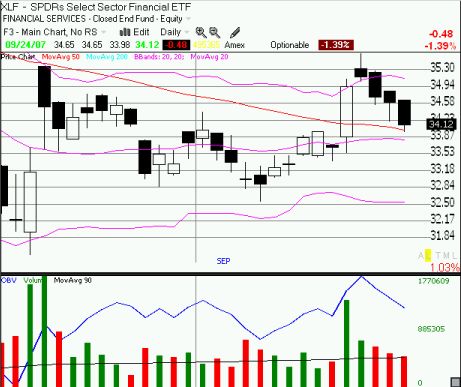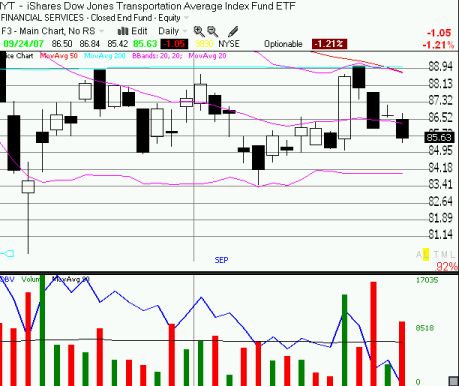Morgan Stanley (MS) gave us the first sign. Then came the homebuilders and the retailers. And as MS, the homebuilders (XHB at new 52-week lows), and retailers (Lowe's and Target gave nasty revenue/earnings warnings tonight but nevermind CROX!) all continue to sell-off, the financials and transports have finally joined the Fed fade parade. The ETF charts below show that the regional banks (RKH) and financials (XLF) in general are now trading at or below the magic moment of the Fed's big surprise. I am a bit late in noting the fade of the transports, but I noticed now after recalling FedEx's earnings warning and the bad news from American Airlines (not really a surprise with oil steadily climbing and the consumer softening, right?).



(Note the XLF is trading right at the bottom of the Fed pop although it is not obvious from the above daily chart).
You must be wondering why I seem obsessed with following out this fade-o-licious action. You may even be saying "But Dr. Duru, you are selectively picking out the worst performing sectors of the market! I can find technology stocks that are making fresh 52-week highs like AMZN, GOOG, RIMM, BIDU, and GRMN!" Ah, yes. Good point. But the Fed did not cut rates to save the tech economy. In fact, the tech economy has been doing just fine thank you very much. The Fed presumably stepped in to save the very sectors that have all now faded the initial reaction to the out-sized Fed rate cuts, and the market is already showing a lack of confidence in the effectivity of those cuts. The homebuilders look like trouble knows no bottom - woe be to us all if Tuesday's housing numbers are even worse than expected. The retailers may begin a new downleg as the warnings from Target and Lowe's re-ignite recession fears. The financials could very well bounce as recession fears turn into hopes for fresh Fed rate cuts. And while the transports are not a specific concern of the Fed, they are typically a tell on the overall health of the economy. It's all a twisted game on the way to stoking inflationary embers and obliterating the U.S. dollar. Finally, despite all this drama, the major indicies are still levitating near the top of the post-Fed pop. How long can we expect the indices to hold up on the backs of inflation-friendly, globally-oriented stocks like tech, energy, and commodities? Methinks we are about to find out this week! I am frankly a bit surprised that the entire market has not already faded the Fed given the sinking action under the covers.
If the market does not survive the gravitational pull of the ever-slowing domestic economy, look for the leveraged, debt-addicts in the market to begin new cat-calls for more rate cuts, worthless dollar be damned. I still think that we have successfully tested the lows for the year, but we have plenty of room for more sickening dips and drops in the market on our way to a positive close to the year.
And now for some bonus commentary. The action in GM's stock was a classic fade the news event. GM ran nearly straight up for a week starting Sept 13 as the market giddily looked forward to the UAW and GM management to settle contract negotiations. As the clock ran out to the final deadline at 11am this morning, it seemed that a deal "had to be" at hand. The CNBC commentary chattered non-stop about inside info and pundit insight that insisted that all the last-minute, late-night buzz was gamesmanship and postering so that both sides could look strong coming out the other end. And who can blame everyone for assuming that these contract negotiations would end just like they all do? After all, the UAW has not gone out on strike against a North American automaker in some 36 years! So, the CNBC crowd smugly greeted the over 4% pop in the pre-market as a sign that it was in the know. Even when GM opened lower than the pre-market pop and immediately faded, I am sure no one looked up in alarm. And as 11am approached, the jig was suddenly over as the UAW shocked the airwaves announcing that it was indeed going on strike. And they insisted the strike was focused on issues of job security and not the health care concessions that Wall Street has been salivating after. The stock sank in a quick instant by more than a point, and after a deadcat bounce, the stock steadily sold off the rest of the day.
So, what's the point? First, when "everyone" is bidding a stock up in anticipation of the same good news, you know the stock is in trouble, at least in the short-term. In GM's case, the only positive outcome would have been the best possible outcome. Who else was left to buy the stock after the news that everyone expected was finally released? In other words, everything was set-up for a fall. Second, never under-estimate the potential of the negative outcome that completely contradicts expectations. Even as I write this, some pundits are likely insisting that there is too much at stake for the UAW and GM to play a game of chicken or armaggedon. After all the volatile trading, GM's stock still ended the day "only" 0.5% down; so many folks have decided to hang around. But it is exactly because so much is at stake that we need to take these broken contract talks very seriously. GM is likely to become the focal point of union pride and survival. It is likely to become the focal point of the cry of the average worker for maintaining some kind of stand in the face of stagnant wages and record corporate profits. It is a great time for the unions to remind American politicians of their influence. And it is a time when many still fear the domestic economy is teetering on recession. Pay very close attention...and care!
Be careful out there!
.468w60h.jpg)